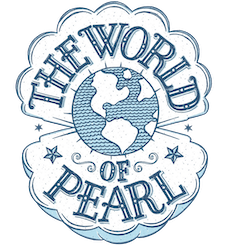“Why are pearls popular in the South?” an executive editor from a prominent southern magazine asked me last week. It is a good question and really got me thinking. Running a popular southern pearl business, I frankly have simply taken it for granted that we southerner love our pearls! But where did this love affair with pearls originate? Here are some of my ideas why pearls are popular in the South!
The entire cultured pearl industry was built on the backbone of Southern river mussels.
Remember the old, beautiful mother of pearl buttons? These were created by factories along the Mississippi River around the turn of the 20th century. By the mid-1900s these button factories were gone and the beautiful mother of pearl buttons were replace by plastic. However, in a way, the impact was felt. The Japanese took note of these buttons and the high quality shell used to make them. Japanese officials traveled to the U.S. to investigate.
In Japan, by the early 1900s, the cultured pearl industry was really taking its hold. A man by the name of Mikimoto had successfully cultured his first pearl in 1893. It was a half-spherical pearl, called a mabe pearl. A few years later he was culturing round pearls. At the time, the only pearls on the market were natural pearls, pearls spontaneously produced by oysters or mussels and they were difficult to find and expensive. The world market loved what Mikimoto was offering.
A cultured pearl is produced by inserting a bead into a bivalve mollusk. It acts as an irritant and along with mantle tissue, the mollusk coats the bead with the same material it uses to create its shell. This is a biological response to this irritant. Since saltwater cultured pearls need this nucleus, using a high quality nucleus bears great value on the successful creation of a cultured pearl. At least that is what the Japanese learned in 1909. The high quality mussel shells produced a higher quality pearl. This is why I state that the entire cultured pearl industry is built on the backbone of Southern river mussels. The Japanese needed our high quality mussel shells to create their high quality cultured pearls.What makes our mussel shells so great? They are dense, thick and white. Most importantly the oysters did not reject or die from the insertion of American mother of pearl shells.

By the 1920s, Japan was importing several hundred tons of mussel shells from the Mississippi and Tennessee Rivers. These imports continued to rise until the 1990s when imports peaked at 7000 tons of shells per year. Due to the high cost of exports, the heyday did come to an end and the Japanese and other cultured pearl producers started experimenting with other sources. Since 2000, imports from Tennessee have declined significantly.

Japan has retained its image as a producer for high quality cultured pearls but it has experienced a few setbacks. One was World War II. After World War II the cultured pearl companies in Japan were unable to sell their pearls to oversees markets because of fear of an illegal pearl trade. The Japanese were forced to sell their pearls to military stores frequented by Allied troops. By the end of 1945, more than 350,000 U.S. personnel, including many Southerners, were stationed in Japan. Many of these troops returned home (and were replaced) by early 1946. What did these men bring back to the South and the rural communities? Pearls. This is when, I believe, the value of pearls were truly felt within the South. Pearls were still considered a high quality, expensive, “regal-like” gem so this did not spur the sale of pearls within southern communities but it did build the appreciation of pearls. Up until this point pearls were seen on notable actresses and flaunted by the flappers. However, the pearls brought back from Japan after World War II were special gems, symbolic of men returning home to their communities. Women would eventually share these pearls with their daughters and granddaughters and a regional appreciation was born.

This is why I believe pearls are popular in the South. However, we can go back even further. Columbus discovered pearls throughout the Americas during his voyages. It is well noted that native Americans were dressed in pearls and used mother of pearl for tool and eating. In Spain, the Americas were named the Land of The Pearls. There was also a Pearl Rush in the U.S. once pearls were discovered in the Mississippi and Tennessee Rivers. So part of our appreciation for pearls could have originated in finding them in our rivers.

When I first investigated this I reached out to the amazing Elisabeth Strack for her opinion on pearls as a popular southern gem. She felt that she could not really answer my question but pointed out the popularity of pearls in early colonial times. In her book, Pearls, Strack reports “It is known today that North American Indians were familiar with pearls from Pinctada radiata, the so-called Atlantic pearl mollusc. An expedition under Sir Walter Raleigh collected 5000 pearls in Virginia alone.” Strack goes on to say, “Captain John Smith… reported at the beginning of the 17 century that Indian tribes from the Atlantic coast used to adorn themselves lavishly with pearls.”
Could our southern love affair with pearls have started with Columbus, with colonization, with the mother of pearl button industry or with the expansion of the cultured pearl industry? Honestly, the are all extremely valid reasons why southerners love their pearls!
I will keep investigating why pearls are popular in the south and let you know what I come up with!
India
I am a modern day treasure hunter who travels the world for gorgeous pearls and amazing adventures. I own a pearl jewelry and jewelry repair business, ThePearlGirls.com, with a cute retail store in Athens, GA. I also have a Pearl Travel business and travel blog at TheWorldofPearl.com.



